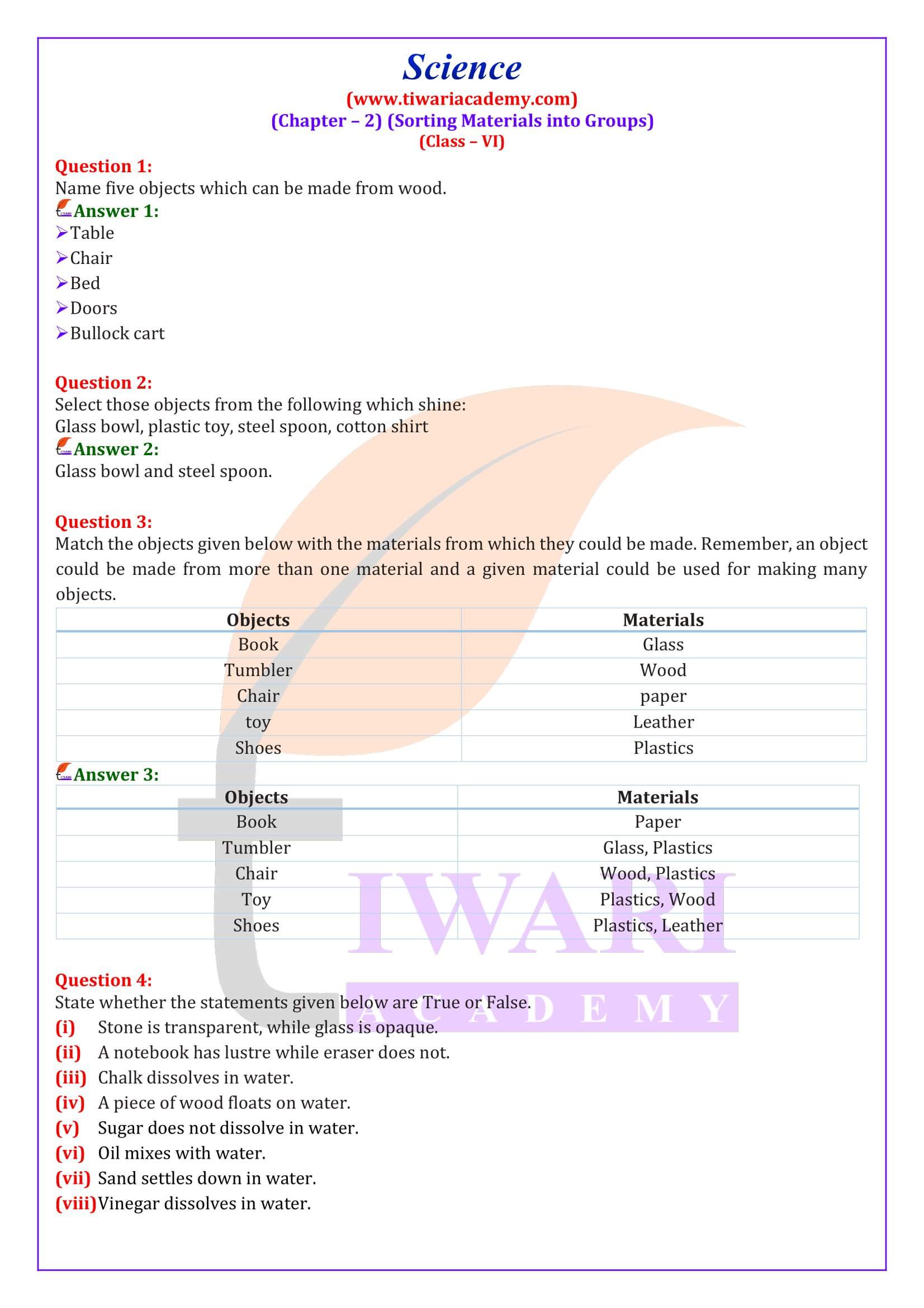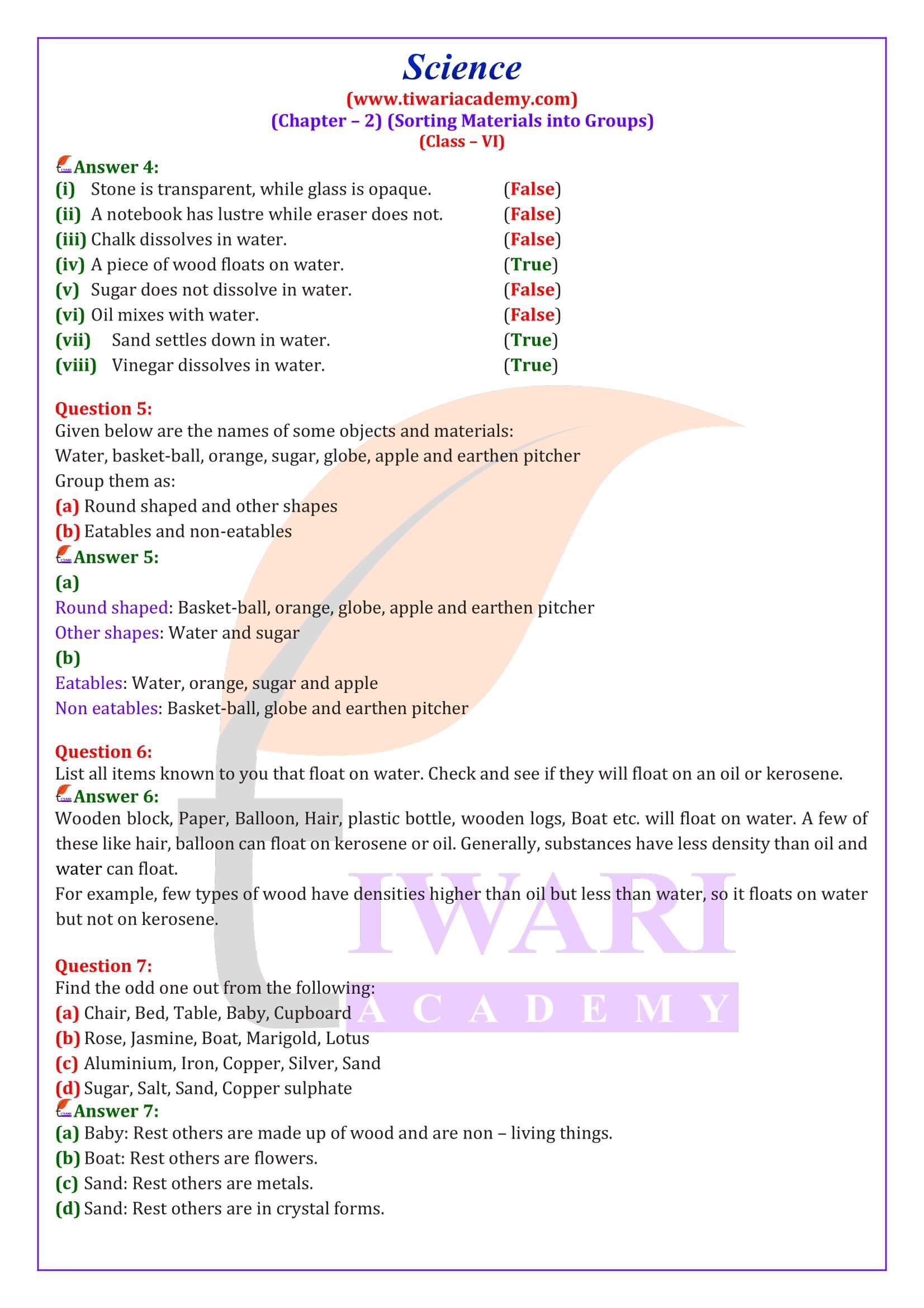NCERT Solutions for Class 6 Science Chapter 2 Sorting Materials and Groups in English and Hindi Medium for new session 2024-25. The question answers and solutions of chapter 2 class 6th science are revised according to rationalised syllabus and new textbooks issued for CBSE 2024-25 exams.
Class 6 Science Chapter 2 in Hindi and English Medium
| Class: 6 | Science |
| Chapter 2: | Sorting Materials and Groups |
| Content: | Textbook and Extra Question Answers |
| Content Mode: | Text and Videos Format |
| Academic Session: | CBSE 2024-25 |
| Medium: | Hindi and English Medium |
NCERT Solutions for Class 6 Science Chapter 2
Class VI Science chapter 2 solutions with Video Format free to download or use online for academic session 2024-25. Download Class 6 Science Offline or Online Apps in English or Hindi Medium. All the Apps and Online Solutions are update for new academic session 2024-25. Download latest class 6 NCERT Books and solutions free in PDF file format. No login or password is required.
Important Keywords on Class 6 Science Chapter 2
| Fibre: | The hair-like materials found in stems and flowers. |
| Yarn: | The thin thread used for knitting or weaving. |
| Combing: | The process of making the cotton fully. |
| Fabric: | The clothes we wear. |
| Retting: | A process by which the jute stems soaked in water for 20 days get softened. |
| Ginning: | A process by which seeds are separated from the fibres. |
| Cotton boll: | The fruits of the cotton plant. |
| Spinning: | The process of drawing out, twisting and winding of fibres into a continuous yarn. |
The Quick Revision Points of 6th Science Chapter 2
- There are two types of fibres—natural and synthetic.
- Clothes protect us from extreme heat and cold.
- Jute is obtained from the bark of the jute plant.
- Fibres like cotton and jute are obtained from plants.
- Cotton is the most important of all natural fibres.
- Fabric from yarns is made by weaving and knitting.
- Cotton clothing is soft and comfortable to wear.
- We wear different types of clothes at different times and places.
Main Tips to Study Class 6 Science Chapter 2
1. Object Around us
In this part of the content focuses on the importance of keeping different materials as a group and their uses in our daily life. We can see many objects around us, such as books, lunch box, table, chair, matchbox, toys and buckets. Now if we wish to make a group of objects that are made of plastic. We find buckets, lunch box, toys in this group. Similarly, make another group of objects that are made from wood. We may find a table, chair, matchbox. In everyday life, we often group materials for our convenience. At home, we usually store things in such a manner that similar objects are placed together. Such an arrangement helps us to locate them easily. Whenever we need clothes to wear, we find in almirah, not in the kitchen. When we get sick, we use the doctor’s thermometer, not a pen or pencil. Remember, every material has its significance. Materials are grouped for our convenience and study to their properties.
2. Properties of Materials
Section 2.2 of class 6 Science chapter 2, provides a clear idea about the different properties of materials which we see in around us. Its different properties are appearance, hardness, transparency, solubility, floatation and conduction of heat and electricity. We learnt before each material has its characteristics or properties that may differ from others.
3. Appearance of Materials
Every material usually looks different from each other. Wood looks very different from iron. Iron gives shine and sound. It conducts heat and electricity, whereas wood has not this type of properties. Remember, materials that have certain properties like lustre, sonorous, good conductors of heat and electricity are called metals. Iron, copper, aluminium and gold are an example of metals.
4. Hardness of Materials
When we touched any material which is made from cotton or sponge, it feels soft while stone, wood, bricks feel hard. As we know that materials which can be compressed, cut, bent or scratch easily are called soft materials. Rubber band, leaf, eraser, cooked rice and chapati are examples of soft materials. In the other hand, some of the materials which cannot be compressed, cut, bent or scratched easily are called hard materials, such as metals, wood, stone etc.
5. Soluble or Insoluble
Materials can be grouped based on their solubility in water. As you know, substances that completely dissolve in water are called soluble substances. These are sugar, salt, lemon juice, etc. Substances that do not dissolve in water are called insoluble substances. Like sand, chalk powder, dust, kerosene etc. Remember, those liquids which do not mix well with water called immiscible. Such as oil. Oil does not mix with water in any circumstances.
6. Objects May Float or Sink in Water
You might have noticed that some materials float in water while other sinks. Materials like sand, sugar, salt, stone sink in water. Materials like dry leaves, wax, oil and wood float on water. Generally, substances have less density than oil and water can float. But, about cotton balls, it initially floats on water, but after a few minutes, it sinks because it absorbs water.
7. Transparency of Materials
Materials can be grouped on the basis of transparency. If you are playing hide and seek with your friends. And they keep themselves behind a glass door. Can you locate them? Your answer will be ‘yes’. Remember, materials through which things can be seen are called ‘Transparent’. Such as glass, water, air, etc. The transparent materials allow almost all the light to pass through them due to which the object or person behind them can be seen clearly. Materials through which we are not able to see anything are called ‘Opaque’, such as wood, iron, wall etc. The materials through which an object can be seen but not clearly is called ‘Translucent’. Muslin cloth is a translucent material. Similarly, paper stained with oil is also an example of translucent material.
Important Questions on Class 6 Science Chapter 2
Select those objects from the following which shine: Glass bowl, plastic toy, steel spoon, cotton shirt.
Glass bowl and steel spoon.
List all items known to you that float on water. Check and see if they will float on an oil or kerosene.
Wooden block, Paper, Balloon, Hair, plastic bottle, wooden logs, Boat etc. will float on water. A few of these like hair, balloon can float on kerosene or oil. Generally, substances have less density than oil and water can float. For example, few types of wood have densities higher than oil but less than water, so it floats on water but not on kerosene.
Find the odd one out from the following: Chair, Bed, Table, Baby, Cupboard
Baby: Rest others are made up of wood and are non – living things.
Find the odd one out from the following: Rose, Jasmine, Boat, Marigold, Lotus
Boat: Rest others are flowers.
Important Questions for Practice
1. Which of the following statements is not true?
(a) Materials are grouped for convenience.
(b) Materials are grouped to study their properties.
(c) Materials are grouped for fun.
(d) Materials are grouped according to their uses.
2. Which type of the following materials is used for making the front glass (wind screen) of a car?
(a) Transparent (b) Translucent (c) Opaque (d) All the above
3. Mixtures of red chilli powder in water, butter in water, petrol in water, and honey in water were given to Radha, Sudha, Sofia and Raveena, respectively. Whose mixture is in solution form?
4. On a bright sunny day, Shikha was playing hide and seek with her brother. She hid herself behind a glass door. Do you think her brother will be able to locate her. If yes, why? If no, why not?
5. It was Paheli’s birthday. Her grandmother gave her two gifts made of metals, one old dull silver spoon and a pair of lustrous gold earrings. She was surprised to see the difference in the appearance of the two metals. Can you explain the reason for this difference?
6. Take a small cotton ball and place it in a tumbler/bowl filled with water. Observe it for at least 10 minutes. Will it float or sink in water and why?
7. You are provided with the following materials— turmeric, honey, mustard oil, water, glucose, rice flour, groundnut oil. Make any three pairs of substances where one substance is soluble in the other and any three pairs of substances where one substance remains insoluble in the other substances.
8. Chalk, iron nail, wood, aluminium, candle, cotton usually look different from each other. Give some properties by which we can prove that these materials are different.
9. Sugar, salt, mustard oil, sand, sawdust, honey, chalk powder, petals of flower, soil, copper sulphate crystals, glucose, wheat flour are some substances given to Paheli. She wants to know whether these substances are soluble in water or not. Help her in identifying soluble and insoluble substances in water.
10. Why do you think oxygen dissolved in water is important for the survival of aquatic animals and plants?
Answers of Important Questions
Answer 1: (c) Materials are grouped for fun.
Answer 2: (a) Transparent
Answer 3: Raveena has got a solution because honey will dissolve in water.
Answer 4: Yes, Ground glass is translucent, so Shikha can be located.
Answer 5: The silver spoon on long exposure to moist air has lost its shine and appears dull whereas gold does not tarnish.
Answer 6: Cotton ball initially floats and then sinks as it absorbs water.
Answer 7: Soluble: (i) honey in water (ii) glucose in water (iii) groundnut oil in mustard oil
Insoluble: (i) turmeric in water (ii) rice flour in water (iii) mustard oil in water
Answer 8: Write on the basis of lustre, hardness, softness, roughness or smoothness.
Answer 9: Soluble in water – Sugar, Salt, Honey, Copper sulphate crystals, Glucose
Insoluble in water – Mustard oil, Sand, Sawdust, Chalk powder, Soil, Petals of flower, Wheat flour.
Answer 10: Dissolved oxygen is available for animal and plants for respiration and survival.




